Recognition of voluntary work – Klaus-Peter Weinreich, a member of our support group, was invited to Hanover for the ‘Day of Voluntary Service’.
The Volunteer Day was proclaimed by the United Nations (UN) in 1985 as International Volunteer Day. The aim of this Global Day of Action is to recognise the commitment of volunteers and motivate even more people to get involved.
The official date worldwide is December 5th. This year's motto is ‘Every contribution counts’.
Many communities have included this ‘Volunteer Day’ in their programme and celebrate it at different times. In Bad Lauterberg, for example, members of the support group have been invited to attend this day several times in recent years. The federal states also invite individuals, groups and associations to the Volunteer Day to honour the volunteers.
The event took place in Hanover on November 22th and was organised by the state government, the savings banks of Lower Saxony and the VGH Insurance. Around 350 people from a wide variety of associations in Lower Saxony were invited to Hanover for the closing event, with 620 individuals, groups and associations applying to attend. This closing event took place in the administrative building of the VGH Insurance and was held under the motto “priceless and voluntary”.
One of the people nominated was Mr. Klaus-Peter Weinreich, who has been maintaining and, when necessary, repairing the machines at the Kings’ hut (Koenigshuette) machine factory for decades, as well as giving visitors a better understanding of the history of the machine factory during guided tours and even putting one or two of the machines into operation. He was nominated by Mr. Bernd Fuhse, the deputy chairman of our association, the Support Group of the king’s hut. And... Mr Klaus-Peter Weinreich was invited to the event in Hanover from the large pool of proposed candidates.
As Peter Weinreich has limited mobility, our chairman, Mr. Christian Mühl, offered to accompany him to Hanover, part of the group was Mrs Elisabeth Mühl, our chairman's wife.
Prime Minister Olaf Lies greeted the invited guests, who were seated in the front row, with a handshake upon their arrival. Mr. Klaus-Peter Weinreich was also sitting in the first row, and he was very pleased about this.
A brief aside: Minister President Olav Lies is familiar with the kings’ hut, he had visited it on 8 March 2019 when he was Minister for the Environment.
Eleven groups and associations were honoured, receiving a certificate and a small token of appreciation in the form of € 4,000. A short film was shown about each group's “invaluable and voluntary” work. Unfortunately, the volunteers who were present and selected but did not belong to these eleven groups or associations were not mentioned by name, which made some of them sad, including Peter Weinreich.
The event was hosted by Mrs Christina von Saß. Many people probably know her from the NDR program ‘Hello lower saxony’ ("Hallo Niedersachsen"). A band provided some lovely entertainment to lighten the mood of the event.
Overall, as Mrs. Mühl told me about this event, it was a successful event that the participants of our support group will surely remember for a long time to come.
Translated with DeepL.com (free version)
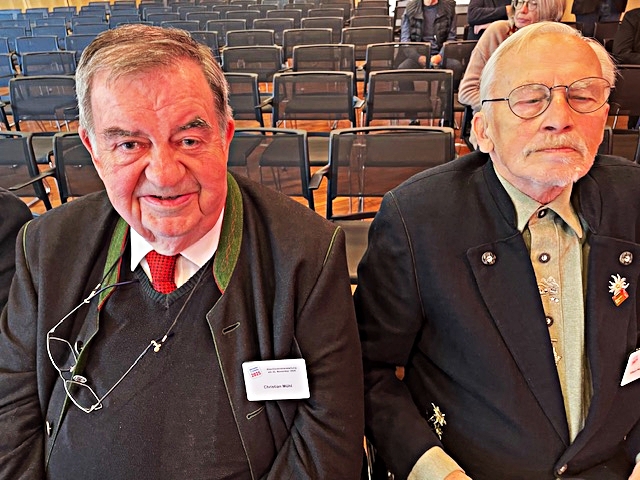
Mr. Christian Muehl - left - and Mr. Klaus-Peter Weinreich - right side
Open Monument Day at the Industrial Monument Koenigshuette (kings’ hut) in Bad Lauterberg 2025
Open Monument Day at the Industrial Monument Koenigshuette (kings’ hut) in Bad Lauterberg
When the board and advisory board members, the organising team from the support group Koenigshuette (kings’ hut) and his helpers began setting up the exhibition stands and making preparations at 8 a.m. under cloudy skies, the weather did not look very promising. But to our delight, the weather changed, and we had a sunny late summer's day with autumnal temperatures in the low double digits.
Pastor Mrs. Bethe led the service, which began at 10 a.m., she was accompanied musically by the Bad Sachsa trombone choir. The service was intended to commemorate the former miners who began their working day with a church service. In these services, they prayed for success at work and protection from accidents.
During two guided tours, visitors were able to immerse themselves in the history of the former ironworks and the history of iron smelting in the Harz Mountains, learn a great deal about the buildings of the ensemble, and view exhibits in the South Harz Ironworks Museum that were produced in the ironworks of the Koenigshuette (kings’ hut) and ironworks of that time.
As always, we were able to attract all kinds of artisans, who demonstrated lacemaking, glass art, stag horn carving, kinetic art and model making of steam engines. There were beekeeping products from Mr. Illner from Bad Sachsa, who
appeared in his usual bee costume and brought along interesting varieties of honey, as well as honey liqueur, beeswax candles, beeswax products for chapped hands and lips, and... lollipops for the children. There were hands-on activities for children, such as making money boxes for themselves and a puzzle rally with the virtual group Brocken Gang, a group of four children and a tame raven.
There were also military vehicles to admire, which had been brought to the kings’ hut for this day. In the late afternoon, one of the vehicles took the children (as well as a few parents as supervisors) on a tour through the city of Bad Lauterberg. Even before the tour, children had been sitting in the military vehicle.
as in previous years the highlight was the demonstration casting, which has long been an integral part of the Open Monument Day and the International Museum Day. It once again attracted a great deal of interest. Since the young, dynamic group from the company ‘Harzer Grauguss’ 2024 took over the demonstration casting, it now begins at 11 a.m. and there are two rounds of demonstration casting. Also on this day, the demonstration casting attracted a large number of spectators, not only children but also adults. As in previous years, the children (and adults) were able to do most of the work by themselves, of cause with the help of the demonstration casters, who only took over the actual casting for everyone. The finished castings were allowed to be taken home. Incidentally, the models are originals from the recent company kings’ hut (Koenigshuette).
Refreshments were also provided, including coffee and cake in the hut tavern. Due to the cool autumn temperatures, the historic cast-iron stove, which was reconnected in 2015, was heated. It was cosy and warm in the hut tavern. Devin K., our youngest member of the support group, did an excellent job of feeding the stove.
In addition, a barbecue was set up in front of the iron store, where steak, bratwurst and currywurst were served, along with a hearty beer, of course.
From early afternoon onwards, Heiko Wiedemann, a well-known figure in Bad Lauterberg, provided musical accompaniment for the event.
Several hundred visitors were counted during the course of the day.
In the hope of repeating this success next year, the day ended at around 5 p.m. to the complete satisfaction of the staff of the support group of the kings’ hut (Koenigshuette). The volunteers of the support group would like to express their sincere thanks to everyone who contributed to the success of this day.
Translated with DeepL.com (free version)
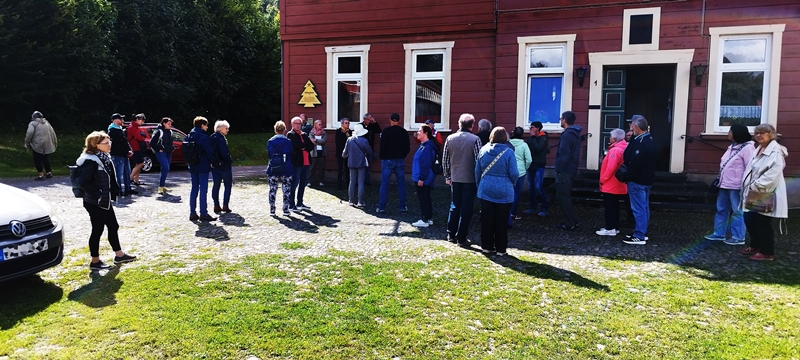
Guided tour on the grounds of the Koenigshuette industrial monument, here: in front of the factory building
Open Monument Day 2025
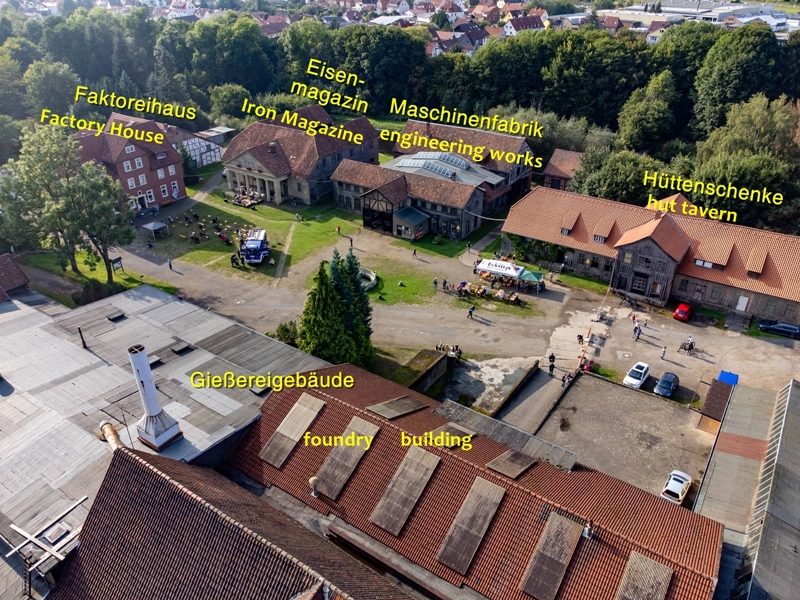
aerial photo from the industriel monument Koenigshuette (kings' hut)
September 14 is Open Monument Day. This year's motto is:
Valuable: totally unaffordable or irreplaceable
The Koenigshuette (King's Hut) – Support Group is participating again and is opening many doors of the industrial monument.
Perhaps when you visit the Koenigshuette (King's Hut), you will have time and leisure to think about what you can say about the motto in relation to the Koenigshuette (King's Hut). Priceless – does this refer to the monetary value needed to maintain such an industrial monument? Or is it irreplaceable? In other words, what can this industrial monument tell us that is so important that its preservation should not be questioned? Feel free to share your opinion with us in the hut tavern or the barbecue stand.
The church service, which takes place at 10 a.m. before the opening of the Open Monument Day, ties in with the mining tradition. Before the miners went down into the mine, there was always a church service in which they prayed for intercession for the day, safe working conditions, and rich yields.
From 11 a.m., the volunteer members will be there for visitors, offering coffee and cake after the church service or as a second breakfast. Visitors can take part in guided tours and immerse themselves in the eventful history of this industrial monument.
Exhibitors will demonstrate their crafts, model builders will show off their skills, and the models are replicas of steam engines and other machines that function just like their originals.
Traditionally, Kings’ hut hosts a glassblowing demonstration, and there are plenty of activities for children. Café hut tavern serves coffee, cake, and cold drinks, and from noon onwards, there is a barbecue in front of the iron warehouse. There is also hearty beer to accompany the steaks, bratwurst, and other fare.
The whole event will be accompanied by music from Heiko Wiedemann, who is well known in and around the city of Bad Lauterberg.
Translated with DeepL.com (free version)
International museums day
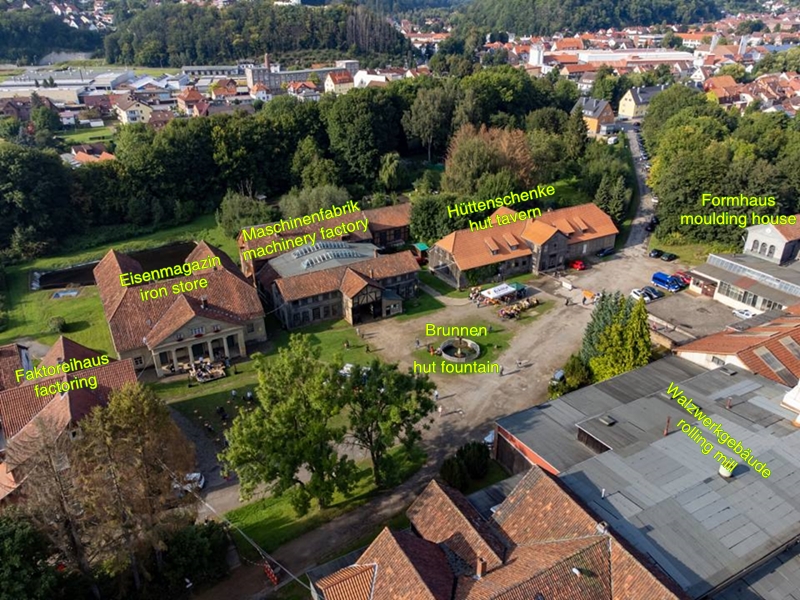
view from above to the area of the kings' hut during a 'international museums day'
The International Museum Day takes place on May 18 this year. This International Museum Day was established in 1978. “With International Museum Day, museums around the world draw attention to their role in society. As an important means of cultural exchange, they not only take responsibility for our cultural heritage, but also promote understanding, tolerance and diversity worldwide,” This is what you can read on the website of the Museum association. The support group kings hut takes part in International Museum Day again this year and opens several doors to take a look behind the scenes.
The day on kings’ hut begins with a church service at 10 a.m., accompanied by music from the 'Waiting Room Jazzband' from Herzberg.
There is a colorful program from 11 a.m. to 5 p.m. From 11 a.m., show casters will demonstrate how iron was cast in the past. Aluminium is used here. Casting iron would go beyond the scope of one day and the temperatures required to cast iron are far too high. Children and adults can take part in the casting process - with the exception of the casting itself - and take the cast pieces home with them. A second round starts at 2 pm.
The café hut tavern opens at 11 a.m. - coffee, tea and cake await visitors (as well as cold drinks, of course), and from 12 noon there will be a barbecue in front of the striking iron magazine. A hearty beer is also available here. As a special feature, you can also order a soup named soljanka here.
The two guided tours with a visit to the South Harz Ironworks Museum offer an insight into the eventful history of the kings’ hut; they start at 1:30 p.m. and at 3 p.m.
Visitors can marvel at working models of historical steam engines and frame saws on the site. - Frame saws, such as those used in joineries, were also produced at the kings’ hut. The models on display are based on original drawings from the kings’ hut company.
A beekeeper will also be showing his products, and a lady will be demonstrating the ancient art of spinning. This is just a small selection from the program of the support group.
We have also come up with something for the children: they can once again solve a puzzle with the Brocken Gang, and the children's church also offers activities for children. But that's not all, there are other hands-on activities, not just for children. Let yourself be surprised.
Translated with www.DeepL.com/Translator (free version)
Invitation to the public lecture on the meeting of members of the support group ‘Königshütte’ (kings’ hut)
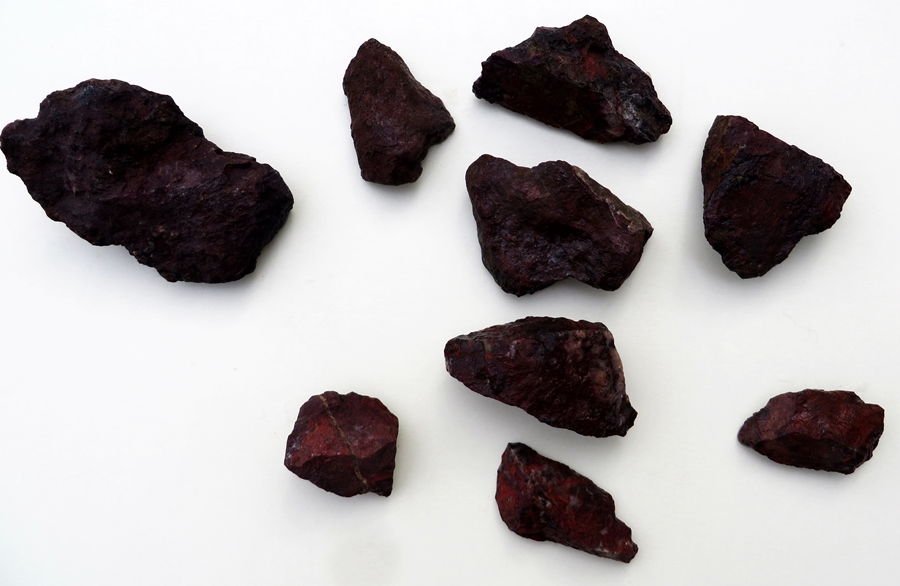
iron ore found in the town of Lerbach (Part of Osterode am Harz)
On Saturday, April 5 (2025), the general meeting of the ‘Förderkreis Königshütte Bad Lauterberg e.V. ‘support group kings’ hut) will take place at the Hotel Riemann in Bad Lauterberg. As in previous years, the general meeting will start at 3 pm with a public lecture. Our first chairman, Mr. Hans-Heinrich Hillegeist, will give this lecture, entitled “On the trail of historic Harz ironworks".
What do you know about iron? For getting in the mood, here comes some - not all-encompassing - background information:
Iron is a naturally occurring chemical element with the element symbol Fe (Latin: ferrum) and atomic number 26. The element has an atomic mass of 55.845 and belongs to the group of metals. Iron is the fourth most common element in the earth's crust, it is not radioactive and it is solid at room temperature. The melting point of iron is 1538 °C, the boiling point 3000 °C. Iron is a base metal. When the metal comes into contact with moist air, there is a change in structure and colour, this process is called corrosion, we all know it as rust.
On earth, iron is mostly found in various ores and iron minerals. The inner core of the earth probably consists of an alloy with an iron content of 80 %.
Iron is also an essential trace element for all living beings, i.e. it is absolutely necessary for life, both for plant and animal life. In mammals, iron is an important basic building block of blood; it is present in the form of haemoglobin in the red blood cells and is necessary for the transportation of oxygen. The daily requirement of iron for an adult is between 10 and 15 mg. Many plant-based foods contain iron. Spinach certainly springs to mind, where a misplaced comma once led to many children being fed spinach because of its supposedly high iron content. But what people probably didn't know at the time was that spinach (iron content 38 mg/kg) contains substances (such as oxalic acid) that inhibit the absorption of iron in the body. But the consumption of dairy products also ensures that iron is poorly absorbed in the intestine. Coffee, black tea and red wine also enables the absorption of iron. In contrast, vitamin C promotes the absorption of the trace element. But that's just a side note.
Back to iron as an ore:
The discovery of iron extraction from iron ore (in this case red ironstone) and charcoal (for smelting) is attributed to the Hittites, an early Indo-European tribe that settled in the Near East in the 2nd millennium. The discovery was made around 1,400 B.C. The Hittites carefully guarded this knowledge of iron smelting as a secret.
After the decline of the Hittite Empire around 1,250 BC, this knowledge spread to the west and east (towards Central Europe and Persia and India respectively).
But even before people in various cultures learned to extract iron from the ore found on earth, they used meteoric iron, also known as celestial iron, which was already known before the actual “Iron Age”.
The relatively late use of iron in most cultures around the world was due to the difficulty of processing it. The complicated smelting process, in which the iron is extracted from the ore, requires knowledge of the correct technique. The iron must also be processed once it has been extracted from the ore before tools can be made from it.
Now a little more information about iron in Europe today:
Around 800 BC, the use of iron finally replaced the use of bronze in Central Europe. The Celts were the bearers of the new culture (Hallstatt period). The word “isaron”, which the Celts and Germanic tribes knew in common, became “iron” in German, “iron” in English and “iarann” in Irish. The exact origin of the Latin term “ferrum” is not yet known.
Incidentally, iron was one of the seven metals of antiquity and was assigned to Mars, the god of war, by the Romans.
Today, iron is also used in electrical engineering due to its magnetic properties. For example, heavy iron cores are installed in transformers to strengthen and concentrate the magnetic field.
With the public lecture, Mr. Hillegeist leaves the support group. He will relinquish his position as first chairman on the date of the general meeting. However, he will remain loyal to the support group as Honorary Chairman. Many members have been friends with him for a long time.
Visitors are cordially invited to attend his lecture “On the trail of historic Harz ironworks”.
As already mentioned, the lecture starts at 3 pm. However, Mr. Hillegeist will remain loyal to the support group as Honorary Chairman. Many members of the support group have been friends with him for a long time.
Translated with www.DeepL.com/Translator (free version)
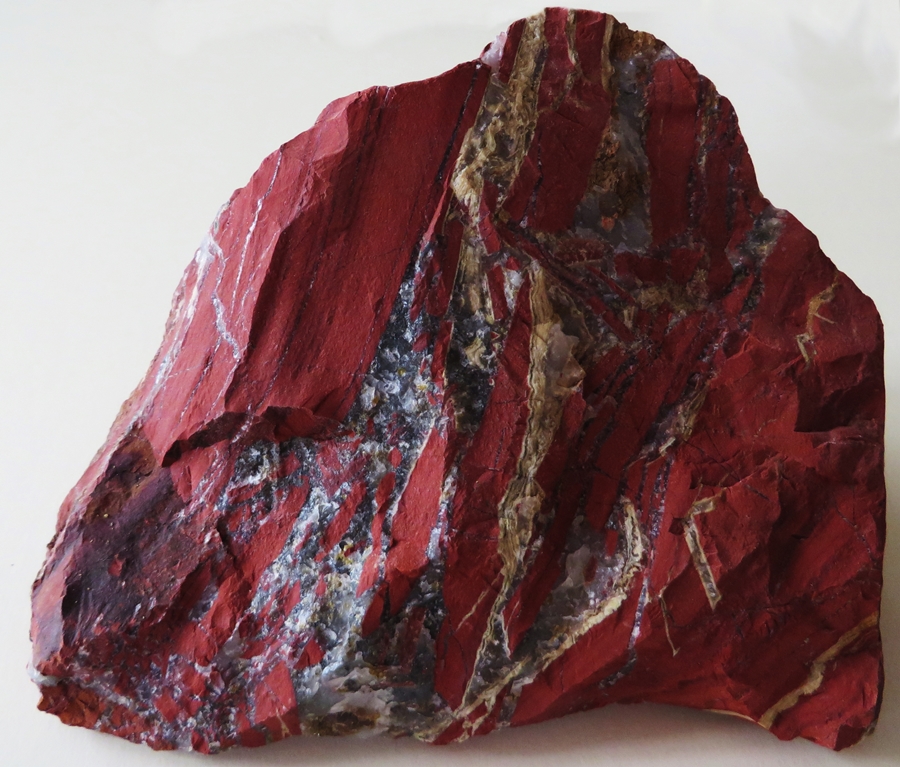
This piece of iron ore is called Jaspis, with inclusions of quartz
